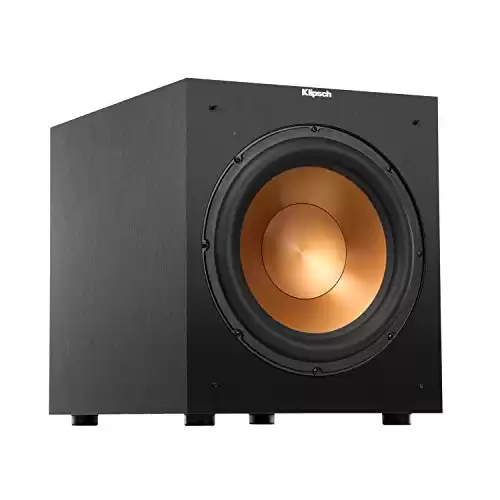When you start talking about subwoofers, it’s not just the size that matters. How the speaker creates sound in your room ensures that you can enjoy the motion of its audio ocean.
Although a subwoofer often looks to be nothing more than a big cabinet that delivers a massive driver, several nuances go into the design of a proper sub.
When you want to find the best subwoofer for your setup, its size and numbers matter. That’s because they’ll determine, with speaker placement, how close you need to sit to enjoy all the sounds you love.
Is It Possible to Sit Too Close to Your Sub?
Sound waves need time to travel for human hearing to pick them up. Sitting too close to a subwoofer can stop listeners from hearing the depth that a composition’s lower frequencies provide. The quality of the speaker also plays a role in where someone sits to listen to a full sound.
When you’re listening to a Hi-Fi track or watching a favorite film, you want to hear as much of the lower register as possible.
The vibrations you get from a subwoofer are great, but you also want your ears tickled by those lower frequencies.
If we aren’t sure that we’re hearing something in its entirety, the natural solution is to scoot closer to the sound source. We believe that we can listen to things better by being close to them.
That’s not always the case when you’re dealing with a sub. It’s entirely possible to sit too close to it – or be too far away.
If you’re ready to start shaking the hardwood floors and boost the boom you have in your room, here are a few principles to follow when considering subwoofer locations.
1. Think About Cord Placement
Some subwoofers require a direct wire hookup. In that situation, you’ll need to ensure there is unfettered access to the receiver in your setup.
You’ll also want to ensure you can hide the wires wherever you decide to set the subwoofer in your setup.
If you have them lying on the floor, people stepping on the cables can cause them to experience premature wear and tear.
Wires on the floor are also a trip hazard you don’t need to have in your room.
Dogs love to chew on wires (as do cats!), so think about how you can manage them appropriately in your setup.
By limiting risks, you’ll tap into your creativity to find an excellent spot for your listening enjoyment.
2. Review the Walls and Corners
When you place a subwoofer in the corner of a room, you can potentially increase its overall output. That means you can have the speaker sound louder without turning up the volume on your system.
Each corner in your room has unique acoustic properties to consider. You’ll want to experiment with each one to see how the woofer sounds.
Some rooms don’t have a lot of floor space, which means a corner placement might not be a viable option.
That’s especially true if the listening area is on the other side of the room. In that circumstance, you might consider placing the speaker against a wall.
Walls can cause a sub to sound rumbly and harsh to the point of it being unpleasant in some spaces.
If you have one with a ported design that allows airflow, try to keep it away from the wall by twice the port’s diameter.
If you give a subwoofer about six to twelve inches of space to use away from the wall, you’ll notice significant improvements to the lower register for your listening enjoyment.
3. Look for the Sweet Spot
When you invest in a wireless subwoofer, you can place it almost anywhere on your floor.
Since every room and space is unique, there isn’t an exact formula for finding where the sweet spot is for your listening enjoyment.
Even your personal listening preferences place a role in finding the sweet spot for placing subs.
That’s why it helps to follow these generic steps to locate the best placement options for your audio setup.
- Settle on the place where you want to listen to music, watch TV, or enjoy other audio broadcasts. Think about the layout of the room to ensure there are places for people to move around without interrupting your session.
- Move the subwoofer around with the sound on until you find a place where the lower register is ideal for your listening enjoyment.
- If you have family or friends who will be with you, make sure to experiment with how the subwoofer sounds in each sitting location to ensure everyone has a positive experience.
If you have a large room and want to cover the space with a smooth, encompassing lower register, it might seem like an impossible task to get the right amount of bass.
In that situation, it might be necessary to add a second subwoofer to your audio setup.
Should I Use Down or Front Firing Subs?
The job of a subwoofer is relatively simple. It needs to deliver a heart-stopping bass that offers a thundering result with each beat. You want the audio to have a pulse that makes your blood pressure rise and your smile get bigger.
Since that thunderous lower register can come from a couple of different places, it’s essential to choose the right subwoofer for your needs to develop a killer audio setup.
You have two options available today. Subwoofers come with a down-firing or a front-firing design.
Each design does what its description suggests. If you purchase a down-firing model, the sound gets directed out of the bottom of the speaker.
With a front-firing model, the audio gets projected out of one of the unit’s sides.
This issue matters because it determines where the vibrations are directed toward the listener. If you want a shaking floor that makes your feet quake, the only option is a down-firing sub that you’ve placed in a corner or right on a joist.
They’re intended for those who want to sit close to the action because the physical experience is more important than the depth of the bass produced.
The front-firing design is the best option when you want to enjoy more audio variations with less vibration. Instead of driving the sound into the ground, it gets put into the listening environment.
All the vibrations are cast-off in the air with the front-firing design.
Is There a Difference in the Sound Between the Two Subs?
Audio waves in the lower Hz frequencies are omnidirectional. That means human hearing cannot perceive the direction from which they originate.
If you sit in the same spot with a down-firing and a front-firing subwoofer, you’ll get almost the same experience. The primary difference is the physical sensation of the vibration.
The primary placement consideration involves the projection of the sound waves into the room.
Since human hearing doesn’t determine where bass sounds originate, you can almost not be too close to a subwoofer.
If you’re right up on it, some of the waves might bounce away before you can hear them, getting absorbed into the soft surfaces of your room.
Beyond that, the only consideration is if the vibrations overwhelm the senses to the point where the bass isn’t as detectable.
What Subwoofer Should I Buy for My Current Setup?
Subwoofers come in various sizes, with eight-, ten-, and 12-inch models the most common options offered. Anyone wanting more lower frequencies in their mix should invest in the biggest woofer possible because of the extra power it offers. Smaller subs can be magnified by placing them in a corner.
My favorite subwoofer at home is the Klipsch R-12SW. I love how it comes in a compact design with an elevated cabinet so that I can place it almost anywhere.
The design is perfect for Surround Sound systems, but we’ve had success pairing it with several options – including PC gaming.
It’s a 12-inch, copper-spun, front-firing design with this woofer that delivers 400W of incredible power.
It plays music just as well as the sound effects in movies and TV shows. If you’ve never felt the bass during a sci-fi battle scene, this speaker will change your life!
The cabinet is a polymer veneer with a satin-painted plinth. It features phase control and low-pass crossover while delivering LFE and Line inputs to be compatible with most receivers.
I don’t have a complicated setup at home. We use a three-shelf TV stand with all the audio equipment underneath.
The sub projects well with our corner setup, creating a fun viewing or listening experience.
You hear the same outcome, whether that’s right next to the television or sitting on the other side of the room.
Investing in a new subwoofer changed everything we thought was great about home entertainment into something better.
I highly recommend making a similar upgrade, especially if you’re concerned about how close you can sit to your speakers.



